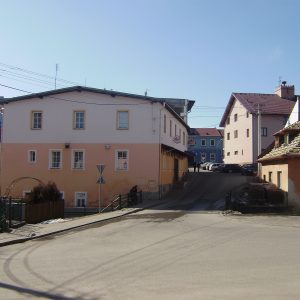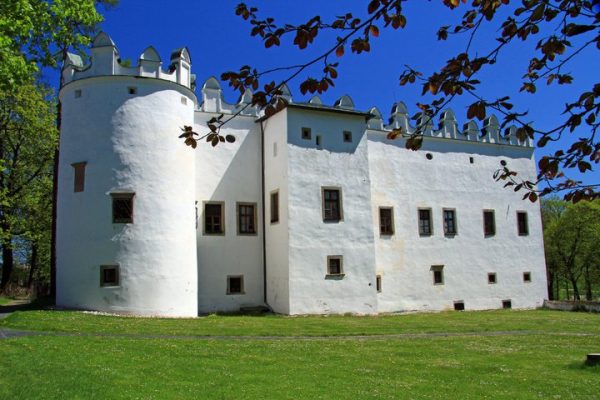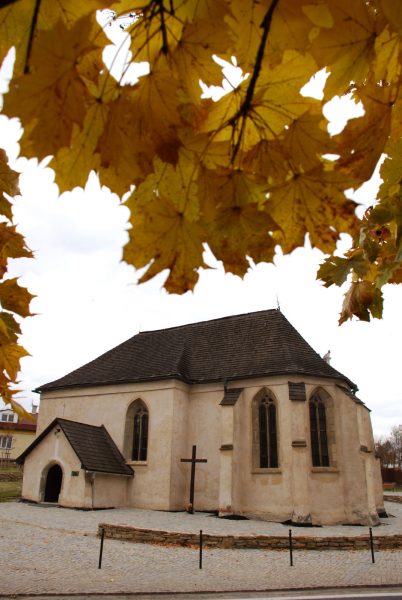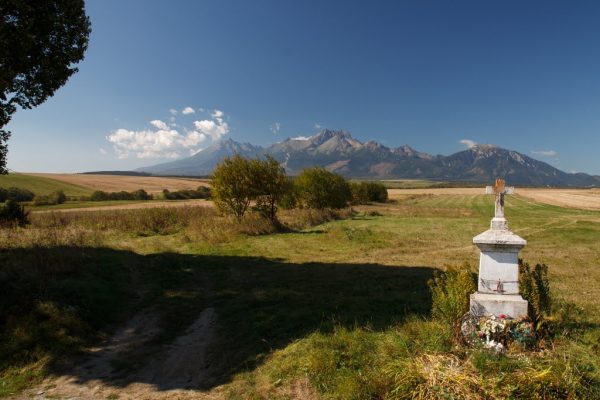13. Kostol sv. Valentína a Mlyny v Spišskej Belej
![]() Kostol sv. Valentína sa podľa záznamu vo farskej kronike postavil v roku 1208. O jeho vzhľade a interiéri vieme z kanonických vizitácií, pričom v najstaršej z roku 1674 sa píše o kostolíku (ako o murovanej stavbe). Vo vnútri boli tri gotické oltáre. Na hlavnom boli 3 sochy: sv. Štefan, Madona s Ježiškom a sv. Valentín. Bočný oltár sv. Mučeníkov a oltár sv. Krištofa. Kostol nemal vežu, zvony boli umiestnené pod strechou kostola nad západným vchodom do kostola. Pokiaľ je údaj o postavení kostola v roku 1208 vierohodný, tak ho postavili nemeckí kolonisti už v prvej vlne kolonizácie, ktorá bola na Spiši od polovice 12. storočia a fungoval do začiatku výstavby farského Kostola sv. Antona. Išlo zrejme o provizórny kostolík, ktorý mal slúžiť do postavenia farského Kostola sv. Antona.
Kostol sv. Valentína sa podľa záznamu vo farskej kronike postavil v roku 1208. O jeho vzhľade a interiéri vieme z kanonických vizitácií, pričom v najstaršej z roku 1674 sa píše o kostolíku (ako o murovanej stavbe). Vo vnútri boli tri gotické oltáre. Na hlavnom boli 3 sochy: sv. Štefan, Madona s Ježiškom a sv. Valentín. Bočný oltár sv. Mučeníkov a oltár sv. Krištofa. Kostol nemal vežu, zvony boli umiestnené pod strechou kostola nad západným vchodom do kostola. Pokiaľ je údaj o postavení kostola v roku 1208 vierohodný, tak ho postavili nemeckí kolonisti už v prvej vlne kolonizácie, ktorá bola na Spiši od polovice 12. storočia a fungoval do začiatku výstavby farského Kostola sv. Antona. Išlo zrejme o provizórny kostolík, ktorý mal slúžiť do postavenia farského Kostola sv. Antona.
Podľa záznamov vo farskej kronike sa okolo roku 1650 vybudoval tesne vedľa severného múra Kostola sv. Valentína mlynský náhon, pričom voda spôsobila jeho podmáčanie a v roku 1707 po požiari došlo k jeho zrúteniu. Oltár sv. Valentína sa preniesol do Kostola sv. Antona do kaplnky sv. Kataríny, ktorá sa premenovala na kaplnku sv. Valentína. Z Kostola sv. Valentína by mala pochádzať aj neskorogotická Madona , ktorá je na severnej stene pri hlavnom oltári sv. Antona.
Mlyny boli nevyhnutné pre riadny hospodársky život mesta, preto hneď po príchode nemeckých kolonistov si umelým kanálom doviedli do mesta vodu až z oblasti Tatranskej Kotliny z krasovej vyvieračky Šumivý prameň, ktorá má výdatnosť 100 l/s. Prvý kanál sa spomína v listine z roku 1290 ako Dorfseifen, (neskôr ho premenovali na Markseifen – dnešný Beliansky potok ) jeho prietok zvýšili v roku 1571 vybudovaním prípojného kanála Neugraben a v roku 1580 vybudovali kanál Rohrgraben. K jednotlivým mlynom viedli mlynské náhony, čím vznikli tzv. Medzijarky. Najstarší bol asi stredný mlyn (Mittelmuhle). V r. 1844 malo mesto z neho príjem 366 florénov. Dnes už neexistuje.
Dolný mlyn (Niedermuhle, Unteremuhle) bol pod terajšou Letnou ulicou neďaleko budovy bývalých Baliarní obchodu (lekvárka). V roku 1844 priniesol do mestskej pokladnice 231 florénov (Weber, 1892). Zachoval sa ako prestavaný rodinný dom.
Poniže dolného mlyna viedol od hate pri Belianskom potoku náhon aj k valchovni, ktorú neskô v r. 1921 prebudoval podnikateľ František Šilon na vodnú pílu, ktorá vyhorela v čase 2. svetovej vojny.
Horný mlyn (Obermuhle) bol postavený okolo roku 1650. Jeho mlynský náhon spôsobil zrútenie severnej steny Kostola sv. Valentína v roku 1707. V roku 1844 bol z neho príjem 438 florénov. Na území mesta fungoval neskôr ako mestský mlyn. Mlyn patril medzi stredne veľké mlyny a v roku 1936 spracovával 30 q obilia denne. Dnes je prestavený na reštauráciu „V mlyne“.
13. The church of St. Valentine
![]() According to records in the parish chronicle, the church of St. Valentine was built in 1208. From canonical visits of the church we know about its shape and its interior. In the earliest documented visit, in 1674, the church is described as a brick building with three Gothic altars. The main altar featured three statues – of St. Stephen, the Madonna with the Infant Jesus and St. Valentine. In the back, there was an altar of the Holy Martyr and an altar of St. Christopher. The church did not have a tower, its bells were placed under the roof of the church, on the western entrance side. If the information about the church’s construction in 1208 is correct, it was built by the first wave of German settlers, who arrived in the Spiš region in the first half of the 12th century and continued coming until the 13th century, when the church of St. Anthony had been completed. This was of course a temporary church, which was meant to serve as a place of worship until the completion of the parish church of St. Anthony.
According to records in the parish chronicle, the church of St. Valentine was built in 1208. From canonical visits of the church we know about its shape and its interior. In the earliest documented visit, in 1674, the church is described as a brick building with three Gothic altars. The main altar featured three statues – of St. Stephen, the Madonna with the Infant Jesus and St. Valentine. In the back, there was an altar of the Holy Martyr and an altar of St. Christopher. The church did not have a tower, its bells were placed under the roof of the church, on the western entrance side. If the information about the church’s construction in 1208 is correct, it was built by the first wave of German settlers, who arrived in the Spiš region in the first half of the 12th century and continued coming until the 13th century, when the church of St. Anthony had been completed. This was of course a temporary church, which was meant to serve as a place of worship until the completion of the parish church of St. Anthony.
According to records in the parish chronicle, a mill wheel was built directly next to the northern walls of the church of St. Valentine around 1650. Water seeped into the ground on which the church was built and in 1707, it had to be demolished. The altar of St. Valentine was moved to St. Anthony’s church, to the chapel of St. Katherine, which was renamed chapel of St. Valentine. It is likely that the late Gothic Madonna statue also was originally a part of the church of St. Valentine. Today, it can be found on the northern wall of the main altar of St. Anthony’s church.
Mills
Mills were crucial for the proper economic development of a town, and for this reason, the German settlers brought water to the towns immediately after they arrived here, with man-made canals, from as far as the Tatranská Kotlina’s karstic Šumivý spring, which had a water output of about 100 liters per second. The first such canal is mentioned in a document from 1290 as Dorfseifen; it was later renamed to Markseifen – today, it is called Beliansky river. The river’s flow volume was increased in 1571 with the construction of an adjunct canal, the Neugraben, and in 1580, the Rohrgraben canal was constructed. Each mill had a flume leading to it, which is how the so-called neighborhood of Medzijarky was established. The oldest was probably the Mittelmuhle. In 1844, the small town took in a revenue of 366 florins from this mill. It no longer exists today.
The lower mill/ Niedermuhle, Unteremuhle/ was located below today’s Letna street, not far from the former site of the packinghouses. In 1844, it brought in a revenue of 231 florins for the town. It has been preserved in the form of a reconstructed family house.
Below the lower mill, a flume led from the water-gate at the Beliansky river as far as to the fullery, renovated by the entrepreneur František Šilon, who transformed it into a water saw, which burned down during the Second World War.
The upper mill/ Obermuhle/ was constructed around 1650. Its flume caused damage to the northern wall of St. Valentine’s church in 1707. In 1844, it brought in a revenue of 438 florins. Later, the city had its own mill on its territory. The mill was of moderate size and in 1936, it had a volume of some 9 tons a day.
13. St. Valentinskirche
![]() Die St. Valentinskirche wurde einer Notiz in der Pfarrchronik zufolge 1208 erbaut. Über ihr Äußeres und Inneres wissen wir aus den kanonischen Visitationen, in deren ältester von 1674 man über diese kleine Kirche als von einem gemauerten Gebäude schreibt. Im Innern befanden sich drei gotische Altäre. Auf dem Hauptaltar standen drei Statuen: die des heiligen Stefan, der Madonna mit dem Jesusknaben und des heiligen Valentin. Die Seitenaltäre waren den heiligen Märtyrern und dem heiligen Christophorus geweiht. Die Kirche besaß keinen Turm, ihre Glocken waren unter dem Kirchendach über dem Westeingang angebracht. Sollte die Angabe glaubwürdig sein, wonach die Kirche 1204 gebaut wurde, dann ist sie von deutschen Kolonisten bereits in der ersten Kolonisationswelle errichtet worden, die in der Zips von Mitte des 12. Jahrhunderts bis zur Errichtung der Pfarrkirche Sankt Antonius im 13. Jahrhundert währte. Wahrscheinlich handelte es sich um eine provisorische Kirche, die bis zur Errichtung der St.-Antonius-Pfarrkirche dienen sollte.
Die St. Valentinskirche wurde einer Notiz in der Pfarrchronik zufolge 1208 erbaut. Über ihr Äußeres und Inneres wissen wir aus den kanonischen Visitationen, in deren ältester von 1674 man über diese kleine Kirche als von einem gemauerten Gebäude schreibt. Im Innern befanden sich drei gotische Altäre. Auf dem Hauptaltar standen drei Statuen: die des heiligen Stefan, der Madonna mit dem Jesusknaben und des heiligen Valentin. Die Seitenaltäre waren den heiligen Märtyrern und dem heiligen Christophorus geweiht. Die Kirche besaß keinen Turm, ihre Glocken waren unter dem Kirchendach über dem Westeingang angebracht. Sollte die Angabe glaubwürdig sein, wonach die Kirche 1204 gebaut wurde, dann ist sie von deutschen Kolonisten bereits in der ersten Kolonisationswelle errichtet worden, die in der Zips von Mitte des 12. Jahrhunderts bis zur Errichtung der Pfarrkirche Sankt Antonius im 13. Jahrhundert währte. Wahrscheinlich handelte es sich um eine provisorische Kirche, die bis zur Errichtung der St.-Antonius-Pfarrkirche dienen sollte.
Aufzeichnungen in der Pfarrchronik zufolge entstand um 1650 direkt neben der Nordmauer der St. Valentinskirche ein Mühlgraben, wobei das Wasser ihre Versumpfung bewirkte und es 1707 nach einem Brand zu ihrem Einsturz kam. Den St.-Valentinsaltar verbrachte man in die St.-Antoniuskirche, und zwar in die Katharinenkapelle, die man in St.-Valentinskapelle umbenannte. Aus der St.-Valentinskirche soll angeblich auch eine spätgotische Madonna stammen, die an der Nordwand beim Hauptaltar des heiligen Antonius steht.
Mühlen
Für ein ordentliches Leben der Stadt waren Mühlen unumgänglich. Deshalb versorgte man die Stadt gleich nach Ankunft der deutschen Kolonisten mit Wasser, das in einem künstlichen Kanal aus dem Tatra-Kessel in die Stadt floss. Das Wasser kam aus einer Karstquelle, aus der 100 Liter Wasser pro Sekunde flossen. Der erste Kanal wird in einer Urkunde aus dem Jahre 1290 als Dorfseifen erwähnt (später benannte man ihn in Markseifen um, den heutigen Belaer Bach). Seinen Zufluss erhöhte man 1571 durch den Bau des Anschlusskanals Neugraben, und 1580 baute man dann noch den Kanal Rohrgraben. Zu den einzelnen Mühlen führten Mühlgräben, wodurch sogenannte medzijárky, eine Art Zwischengräben entstanden. Die älteste Mühle war wohl die Mittelmühle. 1844 hatte die Stadt daraus eine Einnahme in Höhe von 366 Florentinern. Heute gibt es diese Mühle nicht mehr.
Die Nieder- oder Untere Mühle befand sich unter der heutigen Sommergasse (letnou ulicou) unweit des Gebäudes der einstigen Packerei. Sie erbrachte der Stadtkasse im Jahre 1844 231 Florentiner und hat sich als umgebautes Einfamilienhaus erhalten.
Unterhalb der Niedermühle führte der Mühlgraben von einem Stauwehr am Belaer Bach auch bis zu einer Walkmühle, die spätestens 1921 von dem Unternehmer František Šilon zu einer Wassersäge umgebaut wurde, die aber im Zweiten Weltkrieg abbrannte.
Die Obermühle wurde um 1650 gebaut. Ihr Mühlenantrieb bewirkte 1707 den Einsturz der nördlichen Kirchenwand von Sankt Valentin. 1844 erwirtschaftete sie Einnahmen in Höhe von 438 Florentinern. Auf dem Gebiet der Stadt funktionierte sie dann als städtische Mühle. Sie zählte zu den mittelgroßen Mühlen und verarbeitete 1936 30 Doppelzentner Getreide täglich. Heute existiert sie als umgebautes Restaurant unter dem Namen „V mlyne“, zu deutsch „In der Mühle“.
13. Kościół Św. Walentego
![]() Na podstawie kroniki parafialnej wiemy, że kościół Św. Walentego był zbudowany w roku 1208. O jego wyglądzie i wyposażeniu dowiadujemy się z wizytacji kanonicznych, przy czym najstarsza z nich z roku 1674 opisuje go jako kościółek murowany. Wewnątrz znajdowały się trzy gotyckie ołtarze. W głównym były trzy figury – Św. Stefana, Madonny z Dzieciątkiem i Św. Walentego. Boczne to otarz Św. Męczenników i ołtarz Św. Krzysztofa. Kościół nie posiadał wieży, dzwony były umieszczone pod dachem kościoła nad wejściem od strony zachodniej. O ile wzmianka o postawieniu kościoła w 1208 roku jest wiarygodna, to znaczyłoby, że został on wzniesiony przez niemieckich kolonistów podczas pierwszej fali kolonizacji, która miała miejsce na Spiszu w okresie od połowy XII wieku do momentu zbudowania parafialnego kościoła Św. Antniego w XIII wieku. Najprawdopodobniej był to prowizoryczny kościółek, który służył wiernym do chwili postawienia kościoła parafialnego Św. Antoniego.
Na podstawie kroniki parafialnej wiemy, że kościół Św. Walentego był zbudowany w roku 1208. O jego wyglądzie i wyposażeniu dowiadujemy się z wizytacji kanonicznych, przy czym najstarsza z nich z roku 1674 opisuje go jako kościółek murowany. Wewnątrz znajdowały się trzy gotyckie ołtarze. W głównym były trzy figury – Św. Stefana, Madonny z Dzieciątkiem i Św. Walentego. Boczne to otarz Św. Męczenników i ołtarz Św. Krzysztofa. Kościół nie posiadał wieży, dzwony były umieszczone pod dachem kościoła nad wejściem od strony zachodniej. O ile wzmianka o postawieniu kościoła w 1208 roku jest wiarygodna, to znaczyłoby, że został on wzniesiony przez niemieckich kolonistów podczas pierwszej fali kolonizacji, która miała miejsce na Spiszu w okresie od połowy XII wieku do momentu zbudowania parafialnego kościoła Św. Antniego w XIII wieku. Najprawdopodobniej był to prowizoryczny kościółek, który służył wiernym do chwili postawienia kościoła parafialnego Św. Antoniego.
W kronice parafialnej odnotowano też, że około roku 1650 tuż obok kościoła Św. Walentego został wybudowamy młyn wodny, który przyczyniał się do podmywania jego podstawy. Po pożarze w roku 1707 kościół się zawalił. Ołtarz Św. Walentego przeniesiono do kościoła Św. Antoniego, do kaplicy Św. Katarzyny, która od tego czasu nosi nazwę kaplicy Św. Walentego. Z kościoła Św. Walentego prawdopodobnie pochodzi także późnogotycka Madonna, której figura stoi po stronie północnej głównego ołtarza Św. Antoniego.
Młyny
Młyny były niezbędne w codziennym życiu miasta, dlatego zaraz po do przybyciu niemieccy koloniści do ich uruchomienia doprowadzili do miasta wodę. Była ona doprowadzona sztucznym kanałem z odległej Kotliny Tatrzańskiej ze źródła krasowego Šumivy pramen, który miał wydajność 100 l/s. Pierwszy kanał wspomniany jest w dokumencie z roku 1290 jako Dorfseifen, przemianowany później na Markseifen – dzisiejszy Beliansky potok.
Jego pojemność została zwiększona w roku 1571 poprzez doprowadzenie wody bocznym kanałem Neugraben, a w roku 1580 wybudowaniem kanału Rohrgraben. Poszczególne młyny miały swe własne zródła zasilania, w wyniku czego powstały tzw. Medzijarky. Najstarszy był prawdopodobnie młyn środkowy Mittelmuhle. W roku 1844 przyniósł on miastu dochód 366 florenów. Dziś już nie istnieje.
Dolny młyn (Niedermuhle, Unteremuhle) znajdował się poniżej obecnej ulicy letniej, niedaleko paczkowalni (wytwórni marmolady). W roku 1844 dostarczył on do miejskiej kasy 231 florenów (Weber, 1892). Ten młyn po przebudowie służy dziś jako dom rodzinny.
Poniżej dolnego młynu od chaty przy potoku bielskim prowadził kanał wodny napędzający również foluszarnię, w której obrabiano tkaniny i dzianiny wełniane w celu zagęszczenia włókien. Przebudowana w roku 1921 przez Františka Šilona na piłę wodną spaliła się podczas II wojny światowej.
Górny młyn (Obermuhle) został postawiony około roku 1650. Spowodował on w roku 1707 zawalenie północnej ściany pobliskiego kościoła Św. Walentego. W 1844 przyniósł miastu dochód w wysokości 438 florenów. Na terenie miasta funkcjonował później jako młyn miejski. Był to średniej wielkości młyn, który w roku 1936 mielił 30 q ziarna dziennie. Dziś mieści się w nim restauracja „W młynie“.







